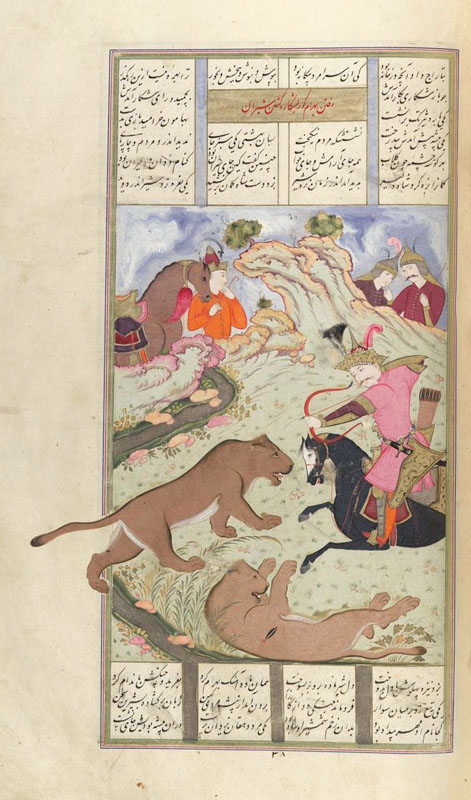Bahrām Gur Hunts Lions
Bahrām Gur (Bahrām V, 420-438AD) gained the throne of Iran by ordeal upon the death of his father Shah Yazdegerd. Bahrām was famous for his brashness, carousing, and overindulgence in the pleasures of life. A hunter par excellence, he is the subject of many anecdotal stories in the Shahnama in which he confronts and slays wild and mythological animals: dragons, a unicorn, gazelles, an onager, and a monkey-lion. Shown here is the often illustrated episode in which he confronts wild lions.
Bahrām Gur, on a black horse, charges from the right, with bow drawn taught and arrow pointed at his prey. He wears a tunic and a jewel studded crown, with a feather and black aigrette of royalty; quivers and bowcase hang from his belt. The horse gallops, its hindquarters cropped by the right frame. Directly before Bahrām, on the left, a lioness with its mouth open advances directly towards him. In the foreground is a second lioness, lying belly up, with an arrow buried deeply in its side. The setting is a sloping hillside that rises to a rocky ridge near the top. Tufts of grass are evenly dispersed over its surface, and at the top is a rock outcropping on which some bushes grow. Beyond the ridge in the upper left are the forequarters of a saddled horse and a groom shown in profile. Balancing them, on the right side, are two helmetted warriors. In the distance is a wash sky of the Moʿin type. A small stream with vegetation on its banks weaves its way down the left side to the foreground.
Painting (without extensions): 22.5 x 16.5 cm. The text is written in four columns above and below the painting, with a rectangular frame enclosing illustration and text, except on the left side where the hind leg and tail of the lion protrudes into the margin. The text has been smeared in a number of places, but the only noticeable damage to the painting occurs just below the neck of Bahrām’s horse. Attributed by Jackson and Yohannan to Fażl ʿAli, and by Robinson to Moʿin. The painting is not signed by either artist, but is executed in excellent Moʿin style, and the detailing is indistinguishable from Moʿin’s other work.
For other paintings by Moʿin illustrating Bahrām Gur in various pursuits, see Ms. E, nos. 9 and 10; Ms. F, no. 11; and Ms. G, folios 331, 347, and 354.
Painting references:
J&Y_1914, p.38, no.39 (not ill.).
Robinson, Cochran4_1972, p.79, no.39 and p.85, fig.23.
Cambridge Shahnameh Project
Text references: Warner, VII, p.21.
Robert Eng
Last Updated: February 16, 2011 | Originally published: June 18, 2003
